
Since I started Practical Golf, I have tested hundreds of products in almost every category imaginable. Because my time is limited, I've said no to hundreds more. Most of my "no's" are for training aid inventions that continue to flood the market. Despite the inventor's best interests, most of them are junk and will not help you become a better golfer.
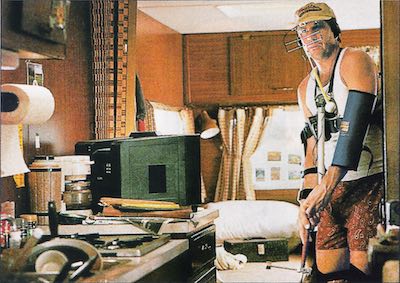
But once in a while, something comes out that grabs my full attention. Last year it was the Perfect Practice Putting Mat and the PRGR Launch Monitor. I never fully know why a product becomes a hit, but sometimes I try something and think to myself, "oh, that's a home run."
This year I believe that product is the Divot Board.
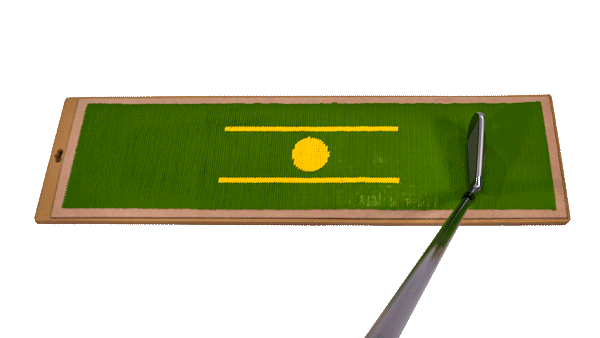
I first noticed the Divot Board when my podcast co-host Adam Young posted a video on Twitter, which went viral. He also called it "one of the simplest and great golf training aids ever created." For a guy who never associates his name with products, especially training aids, I knew that I had to try the Divot Board out.
After testing the Divot Board extensively, I've come to a similar conclusion. This is a fantastic diagnostic tool that addresses one of the biggest problems of practicing on artificial turf. We finally have something that gives golfers crystal clear feedback on one of the most important fundamentals in the golf swing - ground contact.
In this review, I'll take a deep dive into the Divot Board's strengths and weaknesses. As always, my goal is to help you understand how this product works and whether or not it's worth your investment.
Ground Contact is a Fundamental
How your golf club interacts with the turf is perhaps one of the most important ball-striking fundamentals. However, it is rarely spoken about in the instructional world for many reasons.
Another word that's commonly used to describe the skill is called low-point control. To be clear, turf interaction and low point control are not the same but related.
If you think about the club traveling towards the ball on an arc, you want the lowest point of that arc to be in front of the ball. Adam Young talks about this concept a lot, and here is an image of an optimal swing low point showing ball contact first and then turf interaction.

This is where pro golfers really shine. They can strike the golf ball first (in an optimal position on the clubface), and then their club will interact with the turf. If you see the practice area of any PGA Tour professional, you'll see a neat arrangement of divot patterns after their session is complete.

One of the everyday struggles of recreational golfers is that they have very little control of turf interaction and low point control. Some golfers are making contact with the ground too early, which results in poor "fatted" shots. Conversely, others will have the opposite issue and struggle with the "thins."
Whatever your issue is, I consider this to be one of the low-hanging fruits of scoring. If you can improve your golf club delivery around impact, many golfers stand to gain massive jumps in scoring. As I've written before, iron play is how most golfers differentiate themselves from one another in scoring potential.
Artificial Turf's Limitations
Most golfers don't have access to a grass driving range. Because of the high costs of maintenance, you see more golf clubs switching to artificial turf. As such, hitting off mats is the tradeoff we all make. In my 25 years playing golf, I would say 95%+ of my range sessions are on hitting mats, and I believe it's had a somewhat negative influence on my ground interaction on the course.
The problem with artificial turf is that it's not providing proper feedback. You can strike the ground well before the ball and still get a desirable ball flight. However, if you were in real grass, the shot might have looked like this (and traveled about 40 yards).
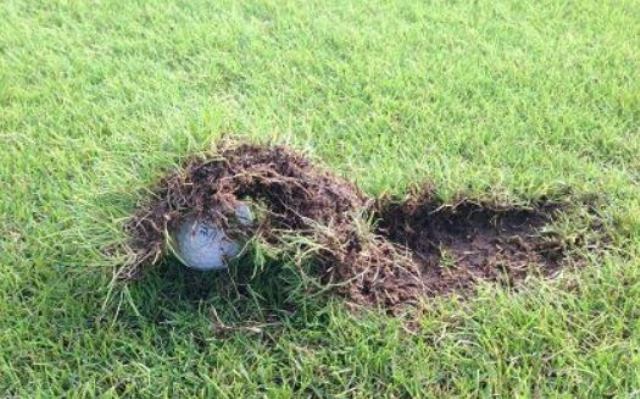
Therefore, golfers will usually adjust their swing mechanics to match their environment. For example, I have a very shallow angle of attack and rarely take divots on the course. I believe it's mostly due to hitting on mats my whole life.
Despite being a skilled iron player, turf interaction is the one part of my game that I don't feel entirely comfortable with. While I don't have issues with hitting heavy iron shots on the course, I still do brush the grass lightly before impact, and if I'm going to make a mistake, it's usually a thin shot.
When I've had opportunities to practice on grass driving ranges for weeks at a time, I've noticed huge strides in my ability to get a more optimal "ball first, then ground." And it's because the grass is giving me the proper feedback on each shot.
This is exactly why I'm so excited about the Divot Board. For the first time, I can get unambiguous visual feedback on where my golf club is contacting the ground.
How the Divot Board Works
Most training aids in the golf industry are either too complicated to use, don't provide great feedback, or are just plain old boring.
The Divot Board's brilliance is its simplicity. All you do is place the ball on the circle, hit your shot, and you'll get a clear visual indication of what happened. Here is a video showing some examples of striking different parts of the board.
The mat has a strong rubber base with a removable board that has sequins on it. When your club touches the surface, it clearly changes from green to white.
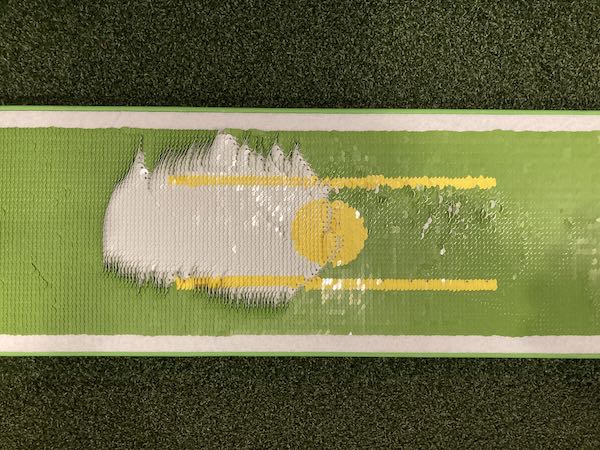
The rubber base is quite strong and absorbs the shock on the impact quite well without being too hard on your joints. Also, the bottom is lined with "teeth," which helps the board stay in place.

This Is Not a Swing Trainer; It's a Diagnostic Tool (and a great one)
Most training aids are swing trainers (if that makes sense). The more popular products that I've used, such as The Orange Whip, DST Trainer, and SuperSpeed Golf, are trying to get you to make some specific change in your golf swing with the way the product is designed.
While I believe the Divot Board can help your swing, I want people to be aware that this is a diagnostic tool. As I stated earlier, most golfers generally have no idea how their golf club interacts with the turf while they practice. Even in my testing, I was surprised at my tendencies.
The goal with this product is similar to why I advocate impact training - your first order of business is to diagnose your patterns and try and do the opposite.
But if you do purchase this product, don't expect it to tell you the how and why of your golf swing. You'll need to take lessons for that advice.
There are several things the Divot Board can tell you about your impact conditions:
- If you're hitting the ground too far behind or in front of the golf ball
- Whether you are striking it too far on the heel or toe of the clubface
- It will even indicate your swing path
How I Would Practice With the Divot Board
As I stated, the Divot Board is not a swing trainer; it's a diagnostic tool. But I believe that most golfers can see improvement simply by paying attention to their patterns and making adjustments.
Noticing Your Patterns
When you first start using the Divot Board, your issues with ground contact should become relatively straightforward.
If you see your club initiate contact several inches behind the ball, your goal is to start moving that line closer and closer towards the ball. Some golfers might have the opposite and notice that their impact residue is far too in front of the ball.
To be clear, I don't think everyone should expect to achieve ball first, then ground contact on every shot. Your goal should be to improve on your less-than-desirable swings gradually.
I've noticed that I tend to strike the ground 1-2 inches behind the ball, but because my angle of attack is so shallow, I "get away" with it on the course. But that doesn't mean I can't improve. I've noticed over the last several weeks that I have been able to achieve two things:
- If I am striking the mat behind the ball, the Divot Board is showing a much thinner pattern, which indicates it's a very light brush (you'll notice the heavier the contact, the bigger of an imprint your club will leave behind).
- More of my shots are initiating contact closer to the ball or in a perfect position.
Additionally, you will notice whether you are striking the ball on the heel or toe of the clubface.

Fight Fire With Fire
One of my favorite ways to practice is playing the opposite game. Or, as I call it, "fight fire with fire."
So, in short, my overall advice is to figure out your tendencies and then consciously try and do the opposite. I know that sounds very simplistic. But I believe that you can improve your results by having the feedback and experimenting with your swing. Most golfers will see progress.
Practicing Without a Golf Ball
Another option is to use the Divot Board without hitting the golf ball. This might be a great option for players who can only take practice swings in their house but not hit balls.
One of the readers of my site, whose son is a very talented junior golfer, ran this drill where he tried to call out various parts of the board to strike.
New game: I call out where his impact needs to be in his backswing. pic.twitter.com/QR48LSgDjm— GolfSpy MPR (@GolfSpyMPR) February 1, 2021
Wedge Practice
I also think the Divot Board can be a life-saver for your wedge practice. I know in my own game and in other golfers, ground contact with wedges is a big issue. I've put a lot of time hitting chip shots and pitch shots with the Divot Board and found it to be valuable (and eye-opening).
Most great wedge players have a more shallow angle of attack, generate crisp contact with the ball, and lightly brush the turf afterward. You can diagnose that contact by seeing a thinner, shorter white line with the Divot Board. You'll want to avoid taking larger divots, which you would notice by seeing wider, larger divot patterns on the board.
Things You Should Know Before Purchasing
While I absolutely love this product, and I foresee it becoming a vital part of my practice routine, there are some things you should be aware of.
It Is Raised Off the Hitting Surface
The Divot Board sits roughly 3/8" above the hitting surface. At first, I considered this a minor drawback because I'd prefer to hit off a level surface. The inventor has plans to make an integrated mat, but I created a workaround because the mat I use has a removable hitting surface.

That being said, I did not notice any major difference in my impact patterns whether I was hitting off a level surface or used the Divot Board slighting above my stance. There are a couple of potential workarounds you could create:
- You could raise the area where you are standing by an equivalent height (don't ask me, I'm the least handy person in the world)
- If you are at the range or home, the Divot Board may be a similar height to the mat. So if room permits, you could place it adjacent to the mat.
It Will Wear Out Eventually
Any product that measures ground interaction has an unfortunate downside. It will not last forever. When you purchase the Divot Board, the included pamphlet manages your expectations for its durability.
One thing that all users will experience is that you'll see some initial wear rather quickly. However, this is normal and will not affect the visual feedback it provides.
Here's the tricky part. Because this product is so new, it's tough to predict how long it will last. Based on your speed and how steep your swing is, golfers will see varying results. A good rule of thumb is to expect anywhere between 1,000 - 3,000 shots. However, some golfers are still going strong at roughly 6,000 shots, I'm told.
So if you are someone who swings hard and hits down on it quite a bit, you likely will get less longevity out of it. Conversely, those with slower swing speeds and shallower attack angles will have a longer lifespan.
When the tiny sequins start to detach from the mat, then you'll know it's time to replace it. The good news is that you don't need to replace the entire board. The Divot Board has removable inserts, which you can see in this video.
https://www.youtube.com/watch?v=dPQlTYJLgWE&feature=emb_logo
As a result, I don't think you should expect to hit all of your shots in each range session with the Divot Board. And I don't think you need to either.
It's Not Cheap, and There Is An Ongoing Cost
The Divot Board currently costs $119.99, which is in line with many other training aids. But one thing to consider is that you will need to purchase a replacement from time to time, depending on how often you use it and your swing speed/ground interaction. The replacement pads cost $39.99.
In my opinion, if you are looking to buy a training aid, this is perhaps one of the best investments on the market right now. Most products that golfers purchase end up collecting dust after several uses. I don't think that will be the case for you with the Divot Board, though.
In a perfect world, it wouldn't cost as much and would not have an ongoing fee. But it is one of the only major drawbacks of the product I can think of.
Divot Board vs. Acu-Strike
The Divot Board is not the first product to measure ground contact. Acu-Strike has been out since 2019 and did win best new product at the PGA Merchandise Show.
I purchased an Acu-Strike (beware of the cheap knockoffs on Amazon) from their website to compare the performance. Spoiler alert - I don't think it's as strong of a product.
For starters, the Acu-Strike sits much higher off the ground than the Divot Board.
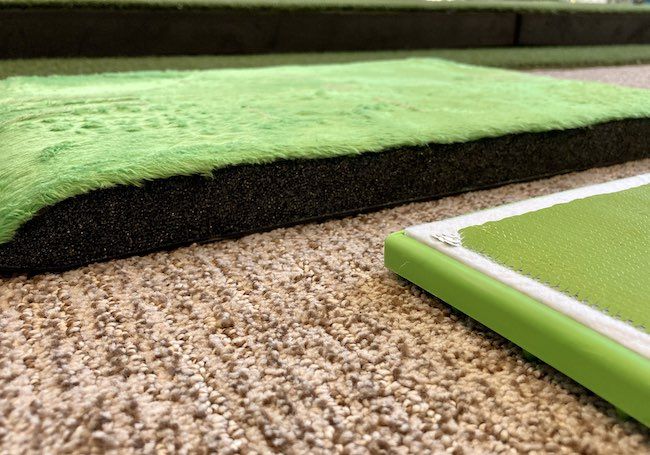
While I felt it wasn't a huge nuisance with the Divot Board, the Acu-Strike's height was problematic, in my opinion. They do sell a "height equalization mat," but that costs an extra $40.
I also noticed that the Acu-Strike's bottom surface does not "cling" to the mat. They do offer a velcro attachment, but I felt that didn't keep in place nearly as well as the Divot Board's bottom.
Additionally, and most importantly, the Acu-Strike failed to deliver as clear feedback from my ground contact. The color change is minimal, and sometimes, it was barely noticeable.
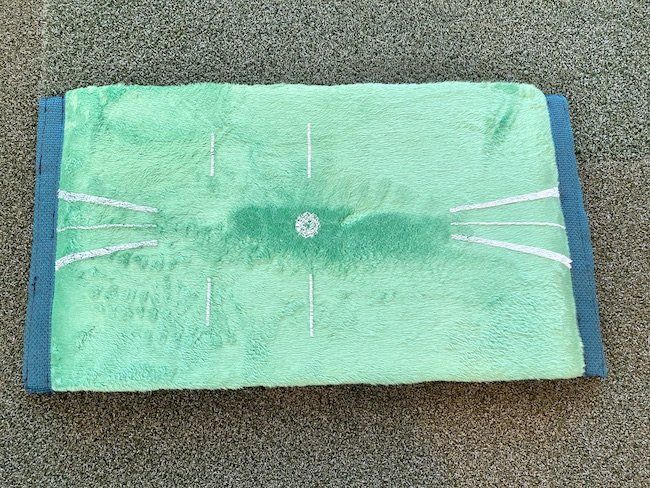
Last but not least, I spoke to several people who have used the Acu-Strike over the long term. Almost all of them told me about durability issues. One golfer who had a much steeper swing told me that the Acu-Strike's surface ripped after 100 shots.
So while the Acu-Strike is $50 cheaper upfront, it's very likely the ongoing cost of using that product will be higher if you plan to use it for the long haul.
That's not to say the Acu-Strike isn't a good feedback tool; I still believe it is. However, when I factor in the clarity of feedback, height issues, and potential ongoing costs from lack of durability - I feel the Divot Board is a stronger choice.
This Is My New Favorite Training Aid
No training aid is perfect, and a lot of them have some serious flaws. The Divot Board is no different. While I think the up-front investment and ongoing cost might be a bit steep (no pun intended), there are significant benefits to using this product. More so than 99% of the other inventions I've seen come and go over the years.
As I mentioned earlier, it's not often that a product grabs my attention in this category. Also, very few make it into my personal practice routine. So I guess my ultimate stamp of approval for the Divot Board is that I plan on using it for the long term. I still have some ways to improve my ground contact, and in the short time I've used it, I already see an improvement in my patterns.
Unfortunately, like many other products right now, there are issues with manufacturing from overseas. The Divot Board sells out fairly quickly each time a new shipment arrives. I have secured a small inventory for Practical Golf readers that you can purchase here (while supplies last).
We care about the protection of your data Read our Privacy Policy